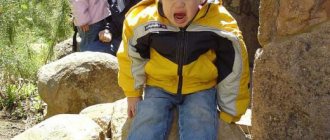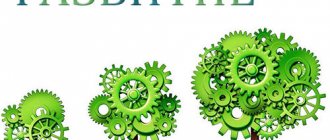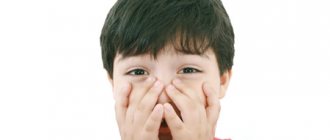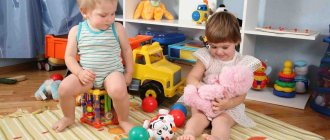Physical development of a 4 year old child
By the age of four, children acquire the following motor skills:
- Confidently jump from a place and from a running start;
- Run, quickly changing direction;
- Stand on one leg;
- Climb a rope ladder;
- Overcome obstacles;
- Walk and stand on tiptoes;
- Tumble forward;
- Ride a scooter and a bicycle with side wheels.
A four-year-old child has fairly well-developed coordination and balance, making various types of physical activity more accessible to the child, such as dancing, gymnastics, and cycling.
Physical metamorphoses
At four or five years old, a child usually ceases to be a chubby little thing, the fatty tissue becomes thinner, muscles and ribs appear. If there are no deviations in the child’s well-being and behavior, you should not be afraid of these changes. On the contrary, this is the time to send your child to the sports section. Even if you do not plan to raise your baby to be a champion, discipline and regular physical activity will certainly benefit him, helping not only to improve health, but also to stimulate intelligence.
In any case, it is necessary to develop the child’s gross motor skills - run and jump with him, play active games, walk as long as possible. At the age of four to five years, it is necessary to develop coordination and endurance.
Speech development in children 4 years old
At 4 years old, a child is actively improving phrasal speech; he can speak in sentences of 4 to 8 words. The baby's vocabulary is already about a thousand words. Nouns are used most often, verbs and adjectives are used a little less often. Also, usually at the age of 4 years, children already know how to coordinate parts of speech with each other (for example, a noun and an adjective) and correctly place stress, so their speech sounds more competent than that of younger children. However, complex lexical structures are difficult for four-year-olds, so they often avoid conjunctions “if,” “although,” “otherwise,” etc.
To keep your child’s vocabulary constantly expanding, read books to your child more often, play with him and just talk.
Speech development occurs actively, as children at this age strive to communicate with peers. They ask adults and each other questions, learn to listen and not interrupt the interlocutor. A 4-year-old child can talk about how his day went, share his impressions of a cartoon, or retell the plot of a fairy tale. At the same time, the baby’s intonations can be very diverse, and speech is supported by facial expressions and gestures.
If you notice speech impediments in your four-year-old child, it is recommended that you consult a speech therapist. The specialist will play sounds for the baby, work on articulation and give advice on how to help the child at home.
The age of the “why”
Reaching the age of four, the child begins to become more interested in the world around him.
He is already fully aware of his own “I”, his character traits are being formed. Physical activity during this period is replaced by a thirst for knowledge of the world. Curiosity should be encouraged by patiently answering all his questions, but it is better to avoid excessive detail in the answer - look for the simplest possible answers. Now is the time to start teaching him to read and count, as well as introduce him to the basics of natural science.
At 4-5 years old, the child enjoys being introduced to culture. Children's performances, matinees, concerts will not only give a lot of positive emotions, but will also broaden his horizons. Discuss with your child the events you attended - this way he will learn to form and express his own opinion.
conclusions
So, 4 years is a period of discovery, both for the baby and for his parents. A four-year-old child actively learns about himself and the world, his abilities and talents manifest themselves. The skills acquired earlier continue to be improved. The child’s intensive physical, mental and personal development occurs: the baby learns to control his body and emotions, memory, attention, thinking, speech and imagination develop. Four-year-olds simply need to communicate with their peers, because the development of children occurs mainly in role-playing games.
Individual advice from a psychologist
Of course, each baby is unique, and its development cannot fully correspond to a certain standard pattern. We recommend that you consult a psychologist to avoid mistakes when raising a 4-5 year old child. Psychology experts will give advice on how to delicately adjust a child’s character, what activities and exercises will be especially useful for him, and how to prepare a child for school. Come with your child to the Insight Center for Psychological Assistance, and we will help you grow him into a harmoniously developed personality.
Difficulties in parenting at 4, 5 and 6 years old
Difficulties in upbringing arise when parents do not know the characteristics of children's behavior and constantly demand certain actions and achievements from the child, do not take into account his personal opinion, do not allow him to make decisions on his own, do not listen, constantly criticize, scold and humiliate.
In this case, the girl or boy completely closes down, stops trusting their parents, does everything in defiance and shows their character, does poorly at school, and then has problems in adult life.
To avoid difficulties in upbringing, you need to start using psychological methods; first of all, you should learn to ask politely, and not order and demand, to respond correctly to hysterics, and to develop your personality.
Share with your friends!
more
Read us in the Zen channel
When should I be concerned about my child's aggression?
Your child will likely grow out of her aggression on her own as she gets older, without any additional help.
Sometimes aggression can be a sign of an undiagnosed learning disability or emotional problem. Ask your GP if your child's aggressive behavior:
- happens every day or most days
- is serious, and may cause harm or damage to her, others, pets or property
- becomes more frequent or severe as she gets older
- involves aggression towards oneself, such as slapping or scratching oneself, or talking negatively about oneself
Content:
- Basic knowledge and skills at 4 years old
- Norms of physical development Differences between boys and girls
- Weight and height
- Physical skills
- What if the child does not speak or speaks poorly?
I. A. Galkina (Ph.D.)
The age from three to five years is called middle preschool. According to L.S. Vygotsky, during this period children develop completely new relationships between thinking and action, an internal plan of action appears that determines meaningful behavior. Let us consider the age-related features of the development of a child from three to five years old. Their knowledge will help parents not to miss important milestones in the development of their children’s personalities, to notice possible difficulties in time and to correct them.
PHYSICAL DEVELOPMENT
- Reaction speed, coordination and speed of movements are noticeably improved, agility and flexibility appear. Now children become good partners in outdoor games. Their gross and fine motor skills improve.
- The proportions of their body change. Now they are approaching the proportions of an adult’s body, the center of gravity is shifting downward.
- Weight increases due to the growth of bone and muscle tissue. Moreover, boys have more muscle tissue, and girls have more fat. An increase in fat mass occurs due to an increase in volume, not the number of fat cells. At this age, the proportionality of the increase in height and weight is important. If you suddenly notice that the weight data has a clear tendency to overtake the height measurement data, it means that the child is becoming overweight. At an early age, it is important to instill in your child a culture of nutrition so as not to increase fat potential.
- The cartilage gradually becomes hard. The correct formation of the skeletal system largely depends on the quality of nutrition. The child’s diet must contain dairy products, fish, meat, and a sufficient amount of vitamins and minerals.
- All internal organs increase in size, their functions improve, approaching adult norms and proportions.
- The nervous system is also improved. The number of nerve cells increases, the number of connections between them becomes more complex and expands.
- By the age of four, a child should already have a full set of baby teeth. If there are less than twenty of them, then you should seek advice from your local pediatrician or dentist.
MOTOR SKILLS
Three years . The child’s motor skills are enriched: he runs confidently, speeds up and slows down, changes direction, can catch a ball and maintain balance, climbs and descends stairs well, and rides a tricycle. At this age, the baby is able to dress and undress independently, knows how to fasten and unbutton buttons, and put on Velcro shoes. At three years old, a child is already well oriented in space and can easily find the object he needs or complete some task of finding a toy. He also has good hand-eye coordination. He already knows how to use scissors, eat on his own, and drink from a cup.
Four years . Motor activity improves: the child can stand and jump on one leg, walk backwards, jump to the side, forward and backward, alternate running with jumping, jump over low obstacles, march to the beat of the music. Also during this period, a preference for the right / left hand is clearly formed.
Five years . Control over body movements is noticeably improved. All the skills that the child acquired before this age are improved. The space for activities is expanding. At this age, the baby is good at catching a ball with both hands, riding a two-wheeled bicycle, rollerblading, jumping rope, deftly overcoming obstacles, walking on a log, and doing simple dance movements.
MENTAL DEVELOPMENT
The age from three to five years is the most important stage in the development of a child. This period of development is characterized by rapid assimilation of information, so parents should take care of organizing exciting activities with their baby.
At the age of three, a child interacts with the world based only on acquired knowledge. He remembers what happened to him in the past and, based on past experience, makes decisions, confirming old ones or acquiring new skills. The child’s memory in this period of development is involuntary: memorizing information and imprinting images occur by themselves. Children easily remember poems, fairy tales, dialogues from films, and empathize with characters from books and films. By the age of five, memory and attention develop significantly: the child remembers up to 5 words at the request of an adult; carries out instructions consisting of 2-3 consecutive actions. Attention becomes voluntary - a child of four or five years old, if he is asked to constantly say out loud what he has in his field of attention, he will be able to hold it for a long time. The stability of attention increases when looking at attractive objects, listening to fairy tales, and performing intellectually significant actions (puzzle games, riddles).
By the age of four to five, mathematical concepts and numeracy skills are developed. Children use the words “many” and “one” in their speech; name geometric shapes and shapes, learn to identify geometric shapes in surrounding objects. They know and name the seasons and parts of the day. There are right and left hands.
The child’s imagination improves; by the age of four or five, the imagination is so developed that with its help the child can create a simple program of actions in his mind. He gradually learns to replace real objects and situations in his imagination with imaginary ones, this ability especially develops by the age of six or seven.
From four to five years old, children begin to think in images. The child easily remembers, reproduces the information received and actively expands his knowledge about the world around him. This leap in a child’s development occurs due to the development of speech and creative thinking.
SPEECH DEVELOPMENT
At the age of three to five years, active development of speech continues: the vocabulary expands significantly, the child begins to use a variety of nouns and verbs, names the location of objects, and characterizes the emotional states of people. The use of prepositions is expanding, imperative forms of verbs are being used, and sentences are becoming complex. The child is able to retell a short fairy tale, compose a story based on a picture, dialogue speech improves: he maintains a conversation, asks questions and answers them correctly. In general, speech becomes more expressive, contextual, i.e. the child is able to describe a situation in such a way that it is understandable without directly perceiving this situation. The period of four to five years is the peak of the sensitive period of speech development, and provided that the pronunciation of the native language is formed and there are no speech therapy problems, the child can be recommended to begin learning a foreign language.
Normally, a four to five year old child should speak clearly and pronounce all sounds correctly. If a child has difficulties with pronunciation, then you should seek help from a speech therapist. Speech disorders can also be a consequence of hearing impairment. There is a law: as a child hears, so speaks. If your child leaves out some sounds, such as hissing sounds, he may not hear them.
In order to develop your child’s speech more intensively, you need to talk to him more often. And it is important that contact be mutual as often as possible, that is, in the form of dialogue. Parents should not limit themselves to the simplest topics; they can already discuss cartoons and books they have read, relationships with peers and adults.
PERSONAL DEVELOPMENT
The age from three to five years is the most important stage in the development of a child as an individual. At this age, long-term memory is formed. The baby already perceives himself as a separate, unique person, and feelings and emotions form childhood memories and his own unique experience. At this age, the child begins to develop and actively develop character traits such as self-esteem, self-worth, and a sense of dignity.
Imitation remains the main mechanism of personality development. The child is guided by the assessments of adults. Knowledge about oneself becomes more stable, self-esteem begins to form. A child of four to five years old evaluates himself more realistically than at the age of three; he reacts to the praise of adults, correlating his successes with it. An important factor in the development of a child’s personality is the group of peers; the child compares himself with other children, they act as a mirror for him - a peer personifies realistically possible achievements in various types of practical activities, helps to determine his own qualities.
At this age, the child does not yet appreciate the complexity of the task facing him; it is important to him that he coped with it and was praised, but what matters is not so much one-time success as the sustainability of success. By correlating his results with the results of other children, the child learns to correctly assess his capabilities. He develops a level of aspirations and develops an internal position.
After three years, the child begins to see himself from the outside and realize his gender identity. This also needs to be taken into account by parents in order to instill the necessary female and male behavior patterns in a timely manner.
GAMES AND TOYS
Play for a child is a leading activity. From the outside it may seem that the child is having fun while playing, but in fact he is doing important work. In the game, children realize their desire for independence, learn patience, perseverance, communicate with peers, control their behavior, and also develop will, imagination, thinking and moral attitudes.
In games, children already adhere to certain rules and strictly control them, think through the plot of the game in advance and divide roles among themselves. Role-playing play at this age is very important, but the child must be able to play not only in company, but also alone - when only his imagination is involved. A child who plays by himself is more independent of the situation; such a child can be left alone for a while, and he will not experience feelings of anxiety. You can gradually teach your child to play independently. You start a game with him, engage him, then leave the room for a few minutes. An enthusiastic child, by inertia, continues to play alone and gets used to the fact that the constant presence of an adult is not necessary.
In order to develop various aspects of a child’s intelligence, it is necessary that the toys be different: toys for intelligence (simple puzzles), toys that develop spatial thinking (constructors, sets of cubes), toys that develop creative thinking (mosaics, kaleidoscope), etc. Notice with what pleasure your baby plays in the sandbox, what intricate figures he creates from raw sand. At home, such a sandbox can be successfully replaced by plasticine and clay. More often engage in modeling, drawing, appliqué, etc. with your child. These activities develop the child's creative thinking and creative abilities.
Middle preschool age is an important stage of child development. He masters a lot of new knowledge, skills and abilities that are extremely important for his further full development. The task of parents is to expand the child’s horizons as much as possible. This age can be called the age of “intellectual hunger” - the baby wants to know about everything and asks a lot of questions, sometimes very unexpected and difficult. It is very important to answer them and form the right values in the child. By doing this in a playful way during this period, you can lay the foundations for moral development, which will certainly bear fruit in later years.
In order for the development of a child aged 3 to 5 years to be successful, it is important not only for the parents to properly raise children, but it is also advisable for children to attend special classes conducted by experienced psychologists. Our children's development center has an additional general developmental program “Psychological developmental activities”, which is designed for children of this age. We will talk about this program in the second part of our article.
How to help a child's development?
Activities that will help a 4-year-old child develop correctly:
- Simple physical and chemical experiments. For example, with water freezing in the cold, with mixing settled water with ink.
- Learning new mathematical concepts: “equal”, “wide-narrow”, “low-high”.
- Reading children's books, retelling their fragments. Retellings can begin with one paragraph; over time, the child will be able to retell a whole chapter.
- Applications and modeling.
- Age appropriate sports: skiing, swimming, running.
Games
Games for developing memory, attention and thinking of four-year-old children:
- Any role-playing games that allow children to use their imagination and imagine themselves in a new role. Such games can be improvised or organized: children can play classic “daughter-mother” games themselves or, under the guidance of an adult, play according to a pre-thought-out plot, for example, “One Day at School” or “At a Doctor’s Appointment.”
- Games to develop emotional intelligence. Ask your child to emotionally depict different moods: show a very tired person, a gloomy cloud, a smiling sun.
- The game “Come up with another name” perfectly develops children's imagination. Invite your child to come up with other names for common objects: a spoon is a “porridge scooper,” boots are “armor against dirt,” rags for wiping dust are “a weapon for cleaning.”
- Age-appropriate didactic games: sorters, puzzles, educational cards.
- Drawing blindly. The child draws without opening his eyes, and then comes up with what the resulting confusion could mean.
Despite noticeable maturation, the main activity for a four-year-old child remains playing. Try to include playful moments in different life situations - even the process of dressing can be framed as a fun game. Without feeling pressure and demands, your child will develop on time and at a pace that is comfortable for him!
Fine motor skills
The development of a baby’s speech and the correct development of thinking and memory depend on well-developed fine motor skills. It’s good if by the age of four the child has the following fine motor skills:
- colors pictures without going beyond the outline;
- tries to keep the pencil straight when drawing dots, does not lift his hand from the sheet of paper;
- traces samples and stencils with a pencil;
- launches the spinning top;
- folds his fingers, showing shapes, for example, “flashlight”;
- laces his own shoes or at least tries to manage the laces;
- strings buttons or beads with large holes onto a thread;
- Cuts out paper shapes with scissors fairly smoothly.
If your child does not yet master each of these skills, it is easy to help him: together learn to tie shoelaces, play with beads, show how to make finger figures.
Logical thinking
The type of thinking is visual and figurative, where a practical nature is manifested. Therefore, the following can be observed:
- Memorizing a large amount of information.
- Improved concentration.
- Finding differences between two pictures.
- Ability to name antonyms.
- Recognizing errors in the image, explaining the correct execution.
- Completing tasks takes less time, and there is no reaction to foreign objects and actions.
Causes
It is no coincidence that the crisis period for seven-year-olds coincides with school adaptation. Internal changes in the psyche are mainly caused by a change in the child’s social role, new types of activities and responsibilities. In general, the causes of the crisis can be divided into three groups:
- Acceptance of a new social role. The child takes an important social role and becomes a schoolchild. Along with the role, he also takes on new responsibilities: studying, sitting through lessons, following a routine, doing homework. At the same time, the baby becomes a classmate, a participant in joint learning and games, friendship, sympathy, and competition. Demands on him are growing, and he, in turn, begins to make claims to others.
- Loss of childish spontaneity. The immediate situational reactions that are typical for children are quickly lost due to the need to take on a new social role. Therefore, the attributes of “adulthood” suddenly appear: independence, decision-making, assessment of situations. The reasons for a child’s actions are not always clear; actions may seem illogical, since he hides their motives.
- Awareness of internal experiences. The baby begins to become aware of his inner self and explore his own emotions. In addition to physiological needs, he begins to feel mental needs. Understands that good grades are needed in order not to disappoint parents, to receive praise from the teacher, and to assert oneself among peers. But everything is not so simple. After all, on the one hand, you want to go for a walk, but on the other, you need to live up to the expectations of your elders. The constant need to choose also becomes a serious cause of identity crisis.
Everyday skills
Four-year-old children can partially take care of themselves: dress and undress, carefully use the toilet, wash and brush their teeth. They are well oriented in their home, they know where specific things should be.
At 4 years old, the child himself strives to master new skills, and parents can teach him new skills in everyday life:
- to make one's bed;
- take dirty clothes to the laundry;
- keep order in a small area of the house, for example, in the bathroom.










